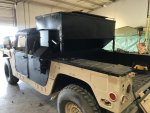Outfitters
New member
- 20
- 1
- 0
- Location
- Guntersville Alabama
I have searched google and here with no definite answer....so thanks in advance for your input.
I have a 1986 M998 and just finished installing a dual voltage 210 Amp Niehoff 1387 alternator (it has the 3225 Regulator).
I currently just have the 14v tap on the alternator grounded to the regulator mounting bolt since I am not using that tap currently.
I want to install a separate 12 volt auto battery under the rear seat and charge it from the 14v tap on the alternator so I can run a large power inverter for 110v, a 12v winch, jump start other vehicles, and run 12v accessories without jepardizing the 24 volt batteries and main vehicle electrical system.
My questions are:
1. Is this alternator designed to do this? (charge two separate systems...one 28v one 14v at the same time)
2. Can I use the same grounding point on the engine block? (is there a conflict with sharing the ground between both the 28v and 14v systems?)
3. Do I need to add any fuse protection or other safety items on this new 14v system?
I have read where others just tap into the series cable on the batteries and then connect the 14v output from the alternator to there, but I like the idea of two separate systems if this will work.
I have a 1986 M998 and just finished installing a dual voltage 210 Amp Niehoff 1387 alternator (it has the 3225 Regulator).
I currently just have the 14v tap on the alternator grounded to the regulator mounting bolt since I am not using that tap currently.
I want to install a separate 12 volt auto battery under the rear seat and charge it from the 14v tap on the alternator so I can run a large power inverter for 110v, a 12v winch, jump start other vehicles, and run 12v accessories without jepardizing the 24 volt batteries and main vehicle electrical system.
My questions are:
1. Is this alternator designed to do this? (charge two separate systems...one 28v one 14v at the same time)
2. Can I use the same grounding point on the engine block? (is there a conflict with sharing the ground between both the 28v and 14v systems?)
3. Do I need to add any fuse protection or other safety items on this new 14v system?
I have read where others just tap into the series cable on the batteries and then connect the 14v output from the alternator to there, but I like the idea of two separate systems if this will work.
Last edited:


